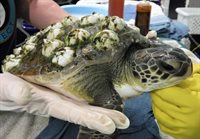
We haven’t seen a lot of activity with local cold-stuns, but any critter that hasn’t made tracks out of Dodge by now is living on the edge. The water and air temps have dropped way below sea turtle comfy. All it takes is a few consecutive days of exposure to cold air and water for these cold-blooded reptiles to get themselves in a heap of trouble.
Turtles still hanging around the inshore waters might be here for several reasons. The long, warm fall meant there was still plenty of good eating, and they were so engaged in lunch that they ignored the cues that the waters were cooling. Or this might be their first year in from their nursery grounds in the Sargasso Sea. There’s something to be said for experience, even if you’re a sea turtle. Sometimes they are already debilitated by another event and just don’t have the strength to migrate. In any case cold-stunning is a life-threatening condition and the little guys are usually the first suffer.
We admit frigid turtles in all sorts of body conditions. Most of them have been battered by the wind, surf and sand and have obvious damage, especially to their unprotected areas like flippers and eyes. They are so cold they cannot move, so they just lie where they strand, subject not only to the elements but also predators like gulls and canines. They often come with a heavy load of barnacles and algae, neither of which is a good look for a sea turtle.
Treatment begins with a slow warm-up in one of two rooms where we can regulate the temperature to prevent sending them into shock. This can take several days, during which time they are pretty much just hanging out defrosting and being treated with fluids and cautionary antibiotics. Once we feel they can tolerate at least some water we introduce food. Getting a cold-stun to begin eating again can be difficult. Our staff has no hesitation about literally crawling along the floor from tank to tank, dangling fish, shrimp and squid from feeders. Or sitting with a turtle for hours trying to convince it to at least try a bite.
Cold-stunning takes a toll on the inside too, damaging organs and bones. It’s not unusual for a turtle that seems to be recovering quite nicely to suddenly start rasping with pneumonia or quit moving a flipper because of bone lesions. Some of our patients have spent years in rehab after developing complications, including recently released green “Belle.” Thankfully almost every cold-stun eventually goes home.
So, what do you do if you see a turtle that has washed up on the beach or in our marshy areas or is in the water floating motionlessly? First, don’t assume it is dead. They literally can’t move, maybe not even blink. Whether the turtle is big or small immediately call our Director of Beach Operations, Terry Meyer at: 910-470-2880. If she is not available, call the hospital during operating hours: 910-329-0222. If the turtle is below the high tide line and in danger of washing out move it above the high tide line if you can do so safely. Ideally you should remain with the turtle until our trained volunteers arrive to retrieve it. If that is not possible find a way to indicate the location of the turtle on the beach by drawing large arrows in the sand or placing beach debris nearby. The State of NC hotline for stranded, sick and injured turtles is 252-241-7367. The state number picks up 24/7. All conservation work for endangered sea turtles at KBSTRRC and on Topsail Island is authorized by the NC Wildlife Resources Commission, ES Permit 22ST05.
We are officially closed to the public for the year. Depending on our patient load we may be able to open for tours sporadically after the first of the year. Check our website www.seaturtlehospital.org for any updates Our gift shop is open year-round online so you can still find all kinds of cool turtle-themed merchandise, much of it exclusive to us. And if you’re looking for something for those impossible-to-buy-for relatives and friends, consider adopting one of our patients.



